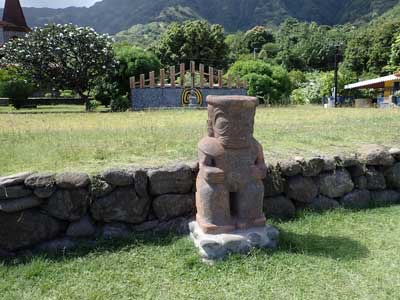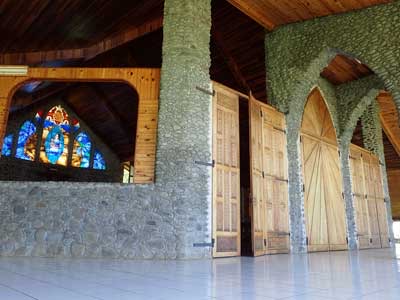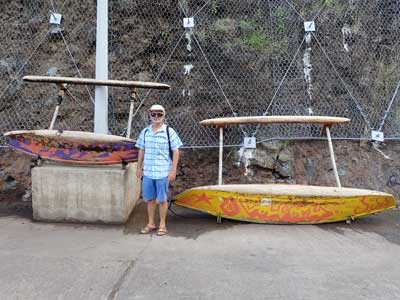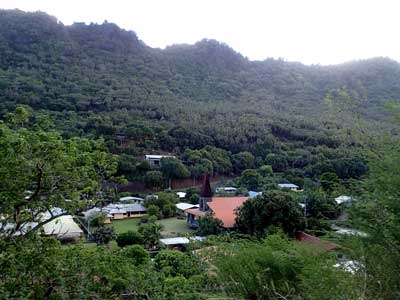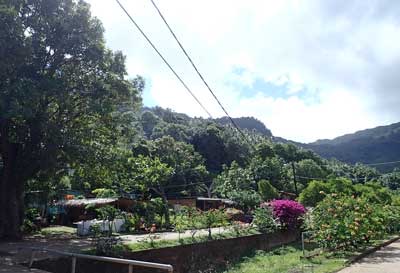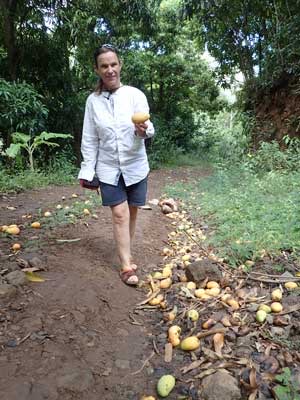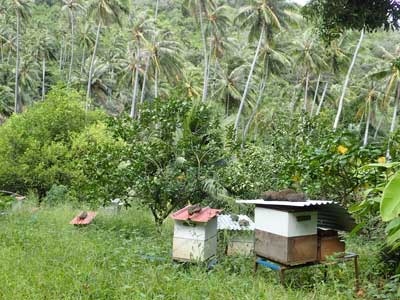Welcome to Vaitahu

9:56.1S 139:06.5W Just after 8am we landed the kayaks on the small river beach in Vaitahu, the administrative centre for the island of Tahuata. Much to our surprise, unlike the other villages we have been to so far, Vaitahu doesn’t have a breakwater and the dock is fully exposed to the swell. The river mouth was the only part of the bay where the surf wasn’t breaking heavily. We parked the kayaks on the grass under a ‘pistachio’ tree. It’s nothing like what we call a pistachio. The fruit is like a small plum, very tart, with a bright green inedible seed. The village centre, with the school, the ‘mairie’, the post office and the church is pretty and well kept. We went in search of a phone box to ring Louis, my contact for the pahi. Outside the ‘mairie’ we met a man and asked if he knew where we would find Louis Tahetia Timau. “He lives in the green house over there, but his wife is in here.Go in!” He invited. “This woman is looking for Louis,” he shouted in Marquesan, opening the door for us. Inside, there were two women, a younger one behind the counter and an older one being served. I wasn’t sure which one was Louis’s wife. A couple of men were waiting, sat on plastic chairs. They shuffled a bit and produced a third chair for me to sit on. They apologised to Franco, there were only three chairs. “Yes?” Said the younger woman. I explained that we were looking for Louis because we wanted to go in search of the pahi. “You need to ring him, don’t forget to add an ‘87’ in front of the number, the phone box is that way.” She told me, pointing further down the road. We were back outside and the older woman caught up with us. “You are looking for me?” She asked. “We are looking for Louis to go and see the pahi,” I explained. “Shall we go over to the green house?” I asked. “Don’t be daft, that’s my house. Louis is up there.” She said, somewhat dismissively, pointing up the valley. “Or you could go to the house on the corner, the one before mine and ask for the mayor’s wife.” Now I was really confused. She must have been Louis’s wife, but didn’t they live together? We found a phone box at the post office but Louis wasn’t answering so I left a message. I was a bit disheartened, trying to organise anything in French Polynesia just felt like hard work. At the house on the corner, we met the mayor’s wife. “Come in, come in, my name is Jeanne-Marie, are you looking for Felix?” She was lovely. “Felix, could he be the tattooist we had heard about?” I wondered. Kolbjorn and Marianne, our Norwegian friends met in Valdivia had told us about this village, it was here that Kolbjorn had had his leg tattooed by a man named Felix. “Jeanne-Marie, we would like to go in search of the pahi,” I explained. “You need Louis! We call him Mr Pahi, I’ll ring him.” No answer. She looked concerned. “Don’t worry,” I said. We’ll come back later.”
Traditional show ground with contemporary tikis
The Catholic Church completed in 1988, a very beautiful space
The outrigger canoes to go out to the boat moorings (Franco for scale), Vaitahu
Vaitahu from above Just around the corner, three men were preparing vast amounts of meat and fish, next to a stylish building that looked like it might be a restaurant. “Is this a restaurant?” We asked. It wasn’t but it did have a billiards table and a football table that it hired out. The owner agreed to make us a lemonade which was delicious and refreshing. “Is there a restaurant in the village?” We asked and she pointed at the next building up the street. The restaurant was less stylish and had a number of plastic tables and chairs marked ‘Paroisse Protestante’ (Protestant Parish) under a tin roof. We approached, mouth watering, looking forward to tasting ‘poisson cru au lait de coco’ (raw fish in coconut milk) or ‘chèvre au lait de coco’ (goat in coconut milk), and maybe breadfruit. “Bonjour, we would like to eat lunch here today,” Franco approached a woman sitting on one of the chairs. “What do you have?” He asked. “Steak-frites or chicken chamin,” she answered with a smile. “Chamin?” Franco turned to me, racking his brains for which local dish this could be. “Err, I think she means ‘chicken chowmein’, the international pseudo-Chinese dish.” I explained.
The restaurant is to the left of the purple flower bush Heading out of the village, we turned onto the first rough track. It was a pleasant shady walk and we gathered up a sack of ripe mangoes on the way.
Kath In mango land
Many beehives off the track Later, before sitting down to our steak-frites, I returned to Jeanne-Marie’s house. A man with an air of gravitas and a forearm covered in tattoos was sitting down to lunch. He had just finished demolishing a huge plate of fish and was about to tuck into a dish of fried plantain bananas. “This is Felix,” Jeanne-Marie introduced me. “Are you the tattoo artist?” I asked. “No, I am the mayor.” He replied, offering me a fried plantain. This time Louis answered the call. He would come and find us at the restaurant. As I walked back to the restaurant, a group of women sat on the steps of the chapel greeted me pointedly as if I had ignored them. I had said hello earlier but they had been too busy chatting to someone in a car to pay me any attention. “Hello! How are you?” I replied with a big grin. “Fine, as always.” They answered cheerfully. The restaurant was full of yachties who had come over by dinghy from one of the sandy bays further north. We knew one, Peter, we’d met him in the anchorage at Fatu Hiva. He is a New Zealander who has spent the last 20 years living in Edinburgh and is sailing back to New Zealand with his young family. The others were all families with children. Boats with children tend to hang out together and can be a bit cliquey. Just in front of the restaurant was a tree heavily laden with giant grapefruit. Franco and I had spotted it earlier and were planning to ask if we could barter for some. Disappointingly we were beaten to it by the families. Then we heard they were paying US$2 per grapefruit! Daylight robbery, we would source our grapefruit elsewhere. Louis turned up and we agreed to meet the following day between 7 and 8 at Jeanne-Marie’s house to go and look for the pahi. After our meal we sat around a while chatting with the family that ran the restaurant. We’d noticed that the older fellow was limping badly. He told us that he suffered from gout. It seems that pretty much everything in the Marquesan diet makes it worse. The younger man that we guessed was his son said that the only thing to do was sew up your mouth. We thought he was being cheeky to his father but it turned out that although he was not yet thirty, he too suffered from gout. “I used to go up to the mountain to hunt wild pigs, but I cannot anymore.” He complained. They told us that most people in the village earned cash from copra, dried coconut that is turned into oil, and that young people spent most of their earnings on alcohol. The village store sold litre cartons of ‘vino tinto’, the cheapest red wine you can get for the equivalent of US$12.70 and a bottle of French plonk for US$17. The son told us that he takes the ferry to Atuona, the small town on Hiva Oa where we made landfall, and buys bottles of rum for US$20 that he sells back in Vaitahu for US$60. Between this and the grapefruit, this young man certainly knows how to turn a profit. A lorry drove by, piled high with mattresses and our hosts explained there was going to be a festival in Hataponi, the village we were anchored off, at the week-end. We must have looked excited. “No, not a party, a prayer festival. People on this island pray a lot, they pray for money.” |
